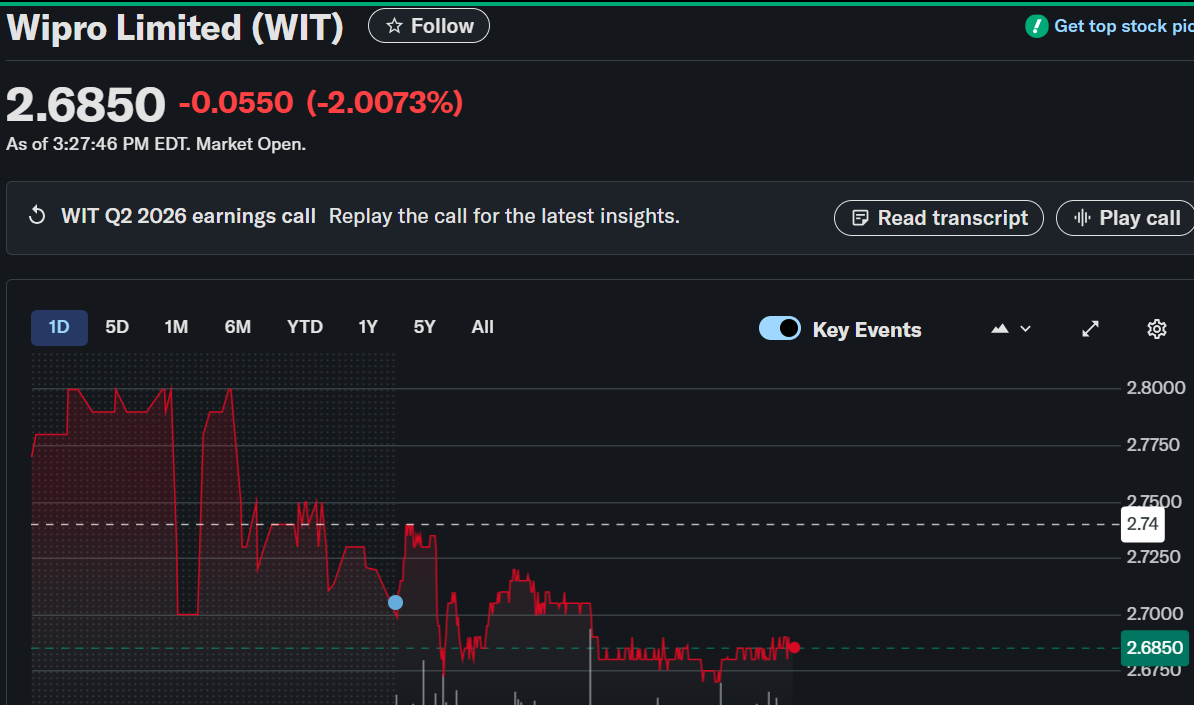Wipro Limited (WIT) Stock: Q2 Earnings Miss EPS Estimates Despite 1.2% Net Income Growth and $2.9B Deal Wins
TLDR
- Q2 EPS came in at $0.03, missing analysts’ forecast of $0.04.
- Net income rose 1.2% YoY to $365.6 million.
- Revenue grew 1.8% YoY to $2.56 billion, aligning with expectations.
- Large deal bookings surged 90.5% YoY to $2.9 billion.
- Q3 IT services revenue guidance set between $2.59B and $2.64B, up to 1.5% sequential growth.
Wipro Limited (NYSE: WIT) stock traded at $2.68, down 2.01% as of 2:32 PM EDT, after the company released its second-quarter 2025 results on Thursday.

Wipro Limited (WIT)
The IT services and consulting firm posted a modest increase in profit but fell short of analysts’ earnings expectations despite strong deal activity and steady margins.
Net Income Rises as EPS Falls Short
For the quarter ended September 30, 2025, Wipro reported net income of $365.6 million, up 1.2% year-over-year, but down 2.5% sequentially. Earnings per share came in at $0.03, missing Wall Street’s estimate of $0.04.
Revenue totaled $2.56 billion, aligning closely with the consensus forecast of $2.57 billion, representing 1.8% year-over-year and 2.5% sequential growth. CEO Srini Pallia credited the revenue growth to solid execution and expanding market traction across Europe and the Asia-Pacific, Middle East, and Africa (APMEA) regions.
“Our revenue momentum is strengthening, with Europe and APMEA returning to growth and our operating margins holding steady within a narrow band,” Pallia stated. “Our strategy is clear: remain resilient, adapt to global shifts, and lead with AI.”
Strong Deal Momentum Despite Sequential Decline
Wipro’s large deal bookings reached $2.9 billion, marking a 90.5% year-over-year increase, while total deal bookings stood at $4.7 billion, up 30.9% YoY. Sequentially, total bookings declined 6.1%, reflecting seasonality and deal timing.
The company’s IT services segment revenue came in at $2.6 billion, up 0.7% sequentially but down 2.1% YoY. Operating margin expanded to 17.2%, a 0.4% YoY increase, despite a $13.1 million provision related to a client bankruptcy.
CFO Aparna Iyer highlighted that Wipro’s large deal momentum remains strong, noting, “Our large deal bookings in the first two quarters have already surpassed the total bookings for full-year FY25.”
Cash Flow, Outlook, and Margins
Operating cash flow stood at $381.5 million, representing 103.8% of net income, though it declined 17.6% sequentially and 20.7% YoY.
For the third quarter ending December 31, 2025, Wipro projects IT services revenue between $2.59 billion and $2.64 billion, translating to -0.5% to +1.5% sequential growth in constant currency terms.
The company maintained its operating margin guidance at around 17%, supported by ongoing efficiency measures and stable demand in key verticals. Voluntary attrition remained at 14.9%, reflecting continued workforce stability.
Stock Performance and Market View
Wipro shares have declined 21.13% year-to-date and 12.48% over the past year, underperforming the S&P BSE SENSEX, which gained 6.82% YTD. Analysts maintain a “buy” consensus on the stock, with a 12-month median price target of $19.51, implying potential upside from current levels.
While the EPS miss weighed on near-term sentiment, Wipro’s robust deal wins, stable margins, and resilient cash flow signal steady fundamentals as it navigates macroeconomic uncertainties heading into 2026.
The post Wipro Limited (WIT) Stock: Q2 Earnings Miss EPS Estimates Despite 1.2% Net Income Growth and $2.9B Deal Wins appeared first on CoinCentral.
You May Also Like

Developers of Altcoin Traded on Binance Reveal Reason for Major Price Drop – “Legal Process Has Begun”

Gate Alpha is launching its 113th round of points airdrops. Holders of the corresponding points can be among the first to receive 0.9 or 4.5 TRUMP.
